关于粉丝文化的作用及意义
- 格式:doc
- 大小:923.00 KB
- 文档页数:7
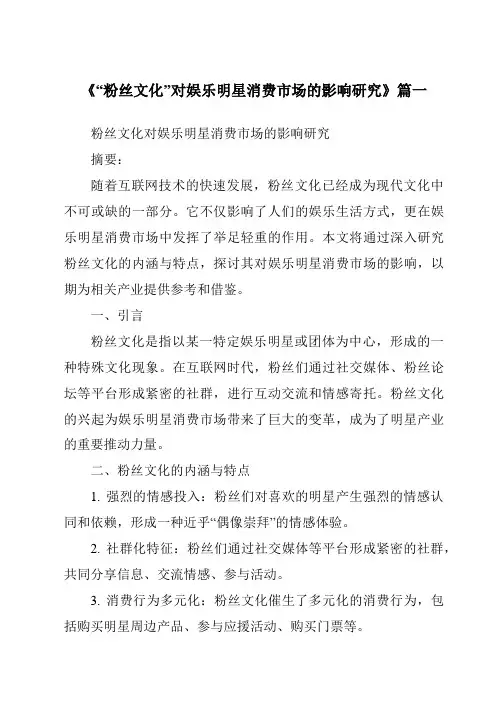
《“粉丝文化”对娱乐明星消费市场的影响研究》篇一粉丝文化对娱乐明星消费市场的影响研究摘要:随着互联网技术的快速发展,粉丝文化已经成为现代文化中不可或缺的一部分。
它不仅影响了人们的娱乐生活方式,更在娱乐明星消费市场中发挥了举足轻重的作用。
本文将通过深入研究粉丝文化的内涵与特点,探讨其对娱乐明星消费市场的影响,以期为相关产业提供参考和借鉴。
一、引言粉丝文化是指以某一特定娱乐明星或团体为中心,形成的一种特殊文化现象。
在互联网时代,粉丝们通过社交媒体、粉丝论坛等平台形成紧密的社群,进行互动交流和情感寄托。
粉丝文化的兴起为娱乐明星消费市场带来了巨大的变革,成为了明星产业的重要推动力量。
二、粉丝文化的内涵与特点1. 强烈的情感投入:粉丝们对喜欢的明星产生强烈的情感认同和依赖,形成一种近乎“偶像崇拜”的情感体验。
2. 社群化特征:粉丝们通过社交媒体等平台形成紧密的社群,共同分享信息、交流情感、参与活动。
3. 消费行为多元化:粉丝文化催生了多元化的消费行为,包括购买明星周边产品、参与应援活动、购买门票等。
三、粉丝文化对娱乐明星消费市场的影响1. 消费市场扩大化:粉丝文化的兴起带动了明星相关产品的销售和消费市场的扩大。
粉丝们愿意为喜欢的明星购买各种周边产品,如明信片、T恤、专辑等。
2. 媒体营销模式变革:粉丝文化推动了媒体营销模式的变革。
通过社交媒体等平台,明星可以与粉丝进行实时互动,提升个人影响力,同时吸引更多消费者关注相关产品。
3. 促进产业链发展:粉丝文化的兴起促进了娱乐产业链的完善和发展。
从音乐、影视到周边产品,形成了完整的产业链条,为相关产业提供了巨大的商业价值。
4. 推动创新与多元化:为了满足粉丝的多样化需求,娱乐产业不断创新,推出更多元化的产品和服务。
如虚拟偶像、粉丝见面会等,丰富了娱乐市场,推动了产业的发展。
四、研究方法与案例分析本研究采用定性与定量相结合的研究方法,通过收集相关数据和案例进行深入分析。

粉丝文化粉丝文化是指以某个明星、品牌、作品等为中心,形成的一种特定的群体文化现象。
随着互联网和社交媒体的发展,粉丝文化不断壮大,并对社会产生了深远的影响。
本文将从粉丝文化的起源和发展、粉丝行为的特点、粉丝文化的影响等方面进行探讨。
粉丝文化的起源可追溯到上世纪90年代,当时流行音乐、电视剧和电影开始拥有大量的粉丝群体。
随着互联网的普及,粉丝们开始利用网络平台进行互动和交流,从而形成了互联网上的粉丝社区。
这些粉丝社区往往具有自己的规则和标准,粉丝们通过分享资讯、表达自己的喜好和支持,建立起紧密的联系和认同感。
粉丝行为的特点主要包括对偶像或品牌的狂热追随、对于相关产品或活动的高度关注、对于与偶像或品牌有关的信息获取和传播的敏感性等。
粉丝们通常会收集并购买与自己喜爱的明星或品牌相关的商品,参加明星或品牌的演出或活动,并通过社交媒体分享这些经历和所拥有的物品,以展示自己的身份和支持。
粉丝文化对社会产生了显著的影响。
首先,粉丝文化为明星和品牌提供了广阔的市场和忠实的消费群体。
粉丝们持续不断的购买和宣传对于明星和品牌的发展至关重要,他们的支持往往能产生巨大的经济效益。
其次,粉丝文化通过社交媒体等平台,成为推动文化产品传播的重要力量。
粉丝们以自己的方式传播和宣传喜爱的明星、电视剧、音乐等作品,为文化产品的推广起到了关键的作用。
此外,粉丝文化还能够带来社交与情感的满足。
粉丝们通过加入粉丝社区,能够找到与自己有共同话题和兴趣爱好的人,并通过互动和交流建立起友谊和亲密关系。
粉丝们之间的互相支持和帮助也使他们感受到归属感和集体认同感。
粉丝文化还为粉丝们提供了一种表达自我和身份认同的方式,通过喜爱的明星或品牌,粉丝们能够塑造自己的形象和价值观。
然而,粉丝文化也存在一些负面影响。
一方面,一些粉丝们狂热的追随和过度的崇拜可能导致他们失去理性和独立思考的能力,盲目地模仿和追求所喜爱的明星或品牌所呈现的生活方式和价值观。
另一方面,粉丝与其他粉丝或反对者之间的争执和冲突也不可避免,这种争执甚至可能升级为恶性事件,给社会秩序和个人权益带来威胁。
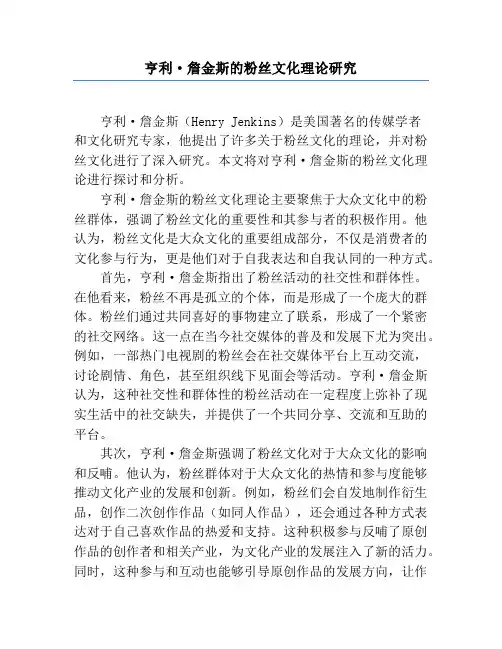
亨利·詹金斯的粉丝文化理论研究亨利·詹金斯(Henry Jenkins)是美国著名的传媒学者和文化研究专家,他提出了许多关于粉丝文化的理论,并对粉丝文化进行了深入研究。
本文将对亨利·詹金斯的粉丝文化理论进行探讨和分析。
亨利·詹金斯的粉丝文化理论主要聚焦于大众文化中的粉丝群体,强调了粉丝文化的重要性和其参与者的积极作用。
他认为,粉丝文化是大众文化的重要组成部分,不仅是消费者的文化参与行为,更是他们对于自我表达和自我认同的一种方式。
首先,亨利·詹金斯指出了粉丝活动的社交性和群体性。
在他看来,粉丝不再是孤立的个体,而是形成了一个庞大的群体。
粉丝们通过共同喜好的事物建立了联系,形成了一个紧密的社交网络。
这一点在当今社交媒体的普及和发展下尤为突出。
例如,一部热门电视剧的粉丝会在社交媒体平台上互动交流,讨论剧情、角色,甚至组织线下见面会等活动。
亨利·詹金斯认为,这种社交性和群体性的粉丝活动在一定程度上弥补了现实生活中的社交缺失,并提供了一个共同分享、交流和互助的平台。
其次,亨利·詹金斯强调了粉丝文化对于大众文化的影响和反哺。
他认为,粉丝群体对于大众文化的热情和参与度能够推动文化产业的发展和创新。
例如,粉丝们会自发地制作衍生品,创作二次创作作品(如同人作品),还会通过各种方式表达对于自己喜欢作品的热爱和支持。
这种积极参与反哺了原创作品的创作者和相关产业,为文化产业的发展注入了新的活力。
同时,这种参与和互动也能够引导原创作品的发展方向,让作品更加符合粉丝们的期待和喜好。
因此,粉丝文化具有重要的创造性和消费力。
第三,亨利·詹金斯对粉丝文化的自我认同和参与方式进行了深入研究。
他指出,粉丝文化是粉丝对于自己喜欢事物的一种身份认同和自我表达。
通过参与粉丝文化,粉丝们能够找到归属感和认同感,从中获得乐趣和满足。
他们将自己的个人经验和情感投放到粉丝活动中,以此强调自己与特定作品或角色的联系。

《亨利·詹金斯的粉丝文化理论研究》篇一一、引言亨利·詹金斯作为媒体研究领域的权威学者,他的粉丝文化理论对现代传播学研究有着重要的影响。
粉丝文化是当代社会文化现象的重要组成部分,它不仅反映了人们对特定文化产品的热爱和追求,还体现了社会文化、经济和技术的变迁。
本文旨在深入探讨亨利·詹金斯的粉丝文化理论,分析其理论框架、研究方法及对当代社会的影响。
二、亨利·詹金斯的粉丝文化理论框架亨利·詹金斯的粉丝文化理论以粉丝群体为研究对象,关注他们在传播过程中的角色和作用。
其理论框架主要包括以下几个方面:1. 粉丝作为积极的受众:詹金斯认为,粉丝不仅仅是被动接受信息的受众,他们还通过互动和再创作积极参与传播过程。
2. 媒介融合与跨文化实践:粉丝文化借助网络、社交媒体等新兴媒介实现跨越时空的互动,并在这一过程中产生丰富的跨文化实践。
3. 集体行动与社会参与:粉丝文化不仅是个人行为的集合,还是一种集体行动和社会参与的体现。
三、研究方法亨利·詹金斯在研究粉丝文化时,主要采用了以下几种研究方法:1. 深度访谈法:通过与粉丝群体进行深入交流,了解他们的心理和行为特征。
2. 观察法:对粉丝群体的社交活动进行实地观察,分析其行为特点和互动模式。
3. 跨学科研究法:综合运用传播学、社会学、心理学等多学科的理论和方法,对粉丝文化进行综合研究。
四、理论应用及对当代社会的影响亨利·詹金斯的粉丝文化理论不仅在学术界产生了广泛影响,还对当代社会产生了深远的影响。
具体表现在以下几个方面:1. 传播模式的变革:粉丝文化的兴起改变了传统媒体时代单向传播的模式,使得传播更加注重互动和参与。
2. 文化价值的重塑:粉丝文化为当代社会提供了新的价值观念和文化内涵,促进了多元文化的交流与融合。
3. 商业价值的挖掘:以粉丝经济为代表的新型商业模式为文化产业带来了巨大的商业价值和社会效益。

《粉丝文化及其传播研究》篇一一、引言随着互联网技术的飞速发展,粉丝文化作为一种新兴的社会现象,已经引起了广泛的关注。
粉丝文化以其独特的魅力,迅速在全球范围内传播开来,成为了现代文化的重要组成部分。
本文旨在研究粉丝文化的形成、发展及其传播机制,以及在当今社会中所扮演的角色和影响。
二、粉丝文化的形成与发展粉丝文化是指围绕特定对象(如明星、偶像、作品等)形成的,以粉丝为主体,以情感、兴趣为纽带的文化现象。
其形成与发展主要受到以下几个方面的影响:1. 互联网技术的发展:互联网的普及为粉丝提供了一个交流、分享的平台,使得粉丝之间的互动更加便捷,从而推动了粉丝文化的形成与发展。
2. 媒体传播的影响:电视、电影、社交媒体等媒体为粉丝提供了更多了解偶像、作品的机会,使得粉丝文化得以传播和扩大。
3. 偶像自身的影响力:优秀的作品、个性和独特的魅力,使偶像具备了较强的感染力,从而吸引更多的粉丝加入。
三、粉丝文化的传播机制粉丝文化的传播机制主要包括以下几个方面:1. 社交媒体:通过微博、抖音、B站等社交媒体平台,粉丝可以轻松地与偶像进行互动,分享自己的感受和观点,从而扩大粉丝文化的影响力。
2. 线下活动:演唱会、见面会、展览等线下活动为粉丝提供了近距离接触偶像的机会,增强了粉丝的归属感和忠诚度。
3. 粉丝社群:通过建立粉丝社群,如QQ群、微信群等,粉丝可以与其他志同道合的人进行交流和分享,共同推动粉丝文化的发展。
四、粉丝文化的影响与作用粉丝文化在现代社会中扮演着重要的角色和影响,主要表现在以下几个方面:1. 文化创新:粉丝文化为文化创新提供了源源不断的动力。
许多粉丝通过创作歌曲、视频、小说等方式,为偶像和作品增添了更多的色彩和内涵。
2. 经济发展:粉丝文化的兴起推动了相关产业的发展,如音乐产业、影视产业、周边产品等。
这些产业的发展为经济增长提供了新的动力。
3. 社会影响:粉丝文化的传播不仅影响了人们的价值观和审美观,还对社会的道德风尚产生了积极的影响。
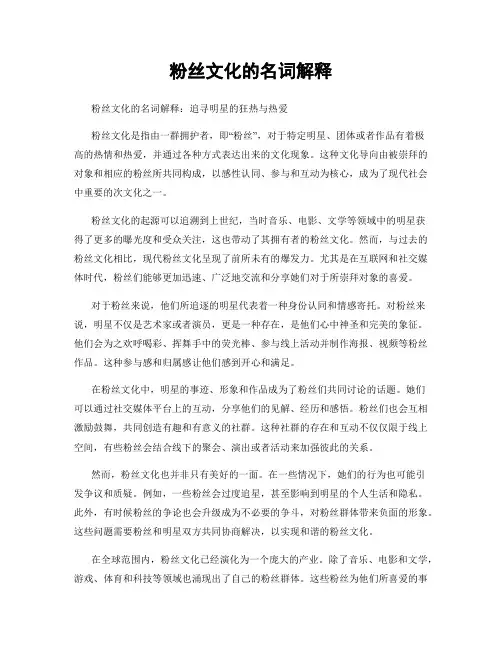
粉丝文化的名词解释粉丝文化的名词解释:追寻明星的狂热与热爱粉丝文化是指由一群拥护者,即“粉丝”,对于特定明星、团体或者作品有着极高的热情和热爱,并通过各种方式表达出来的文化现象。
这种文化导向由被崇拜的对象和相应的粉丝所共同构成,以感性认同、参与和互动为核心,成为了现代社会中重要的次文化之一。
粉丝文化的起源可以追溯到上世纪,当时音乐、电影、文学等领域中的明星获得了更多的曝光度和受众关注,这也带动了其拥有者的粉丝文化。
然而,与过去的粉丝文化相比,现代粉丝文化呈现了前所未有的爆发力。
尤其是在互联网和社交媒体时代,粉丝们能够更加迅速、广泛地交流和分享她们对于所崇拜对象的喜爱。
对于粉丝来说,他们所追逐的明星代表着一种身份认同和情感寄托。
对粉丝来说,明星不仅是艺术家或者演员,更是一种存在,是他们心中神圣和完美的象征。
他们会为之欢呼喝彩、挥舞手中的荧光棒、参与线上活动并制作海报、视频等粉丝作品。
这种参与感和归属感让他们感到开心和满足。
在粉丝文化中,明星的事迹、形象和作品成为了粉丝们共同讨论的话题。
她们可以通过社交媒体平台上的互动,分享他们的见解、经历和感悟。
粉丝们也会互相激励鼓舞,共同创造有趣和有意义的社群。
这种社群的存在和互动不仅仅限于线上空间,有些粉丝会结合线下的聚会、演出或者活动来加强彼此的关系。
然而,粉丝文化也并非只有美好的一面。
在一些情况下,她们的行为也可能引发争议和质疑。
例如,一些粉丝会过度追星,甚至影响到明星的个人生活和隐私。
此外,有时候粉丝的争论也会升级成为不必要的争斗,对粉丝群体带来负面的形象。
这些问题需要粉丝和明星双方共同协商解决,以实现和谐的粉丝文化。
在全球范围内,粉丝文化已经演化为一个庞大的产业。
除了音乐、电影和文学,游戏、体育和科技等领域也涌现出了自己的粉丝群体。
这些粉丝为他们所喜爱的事物付出了大量的时间和金钱,从购买相关产品、参与粉丝活动到为明星投票,粉丝们的贡献不可忽视。
总之,粉丝文化代表了一种重新定义个体与集体关系的文化现象。
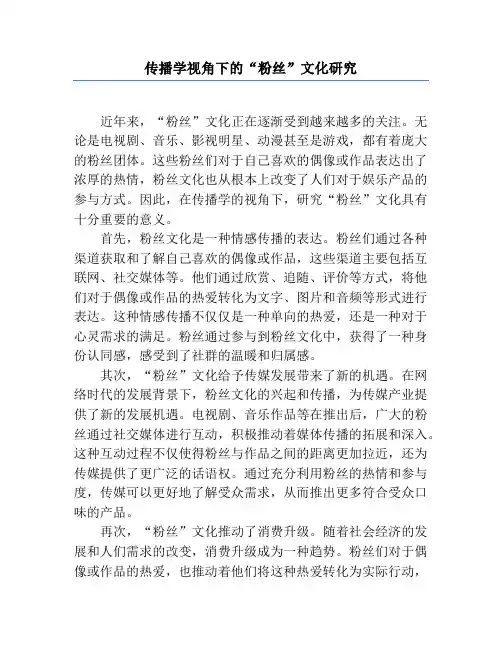
传播学视角下的“粉丝”文化研究近年来,“粉丝”文化正在逐渐受到越来越多的关注。
无论是电视剧、音乐、影视明星、动漫甚至是游戏,都有着庞大的粉丝团体。
这些粉丝们对于自己喜欢的偶像或作品表达出了浓厚的热情,粉丝文化也从根本上改变了人们对于娱乐产品的参与方式。
因此,在传播学的视角下,研究“粉丝”文化具有十分重要的意义。
首先,粉丝文化是一种情感传播的表达。
粉丝们通过各种渠道获取和了解自己喜欢的偶像或作品,这些渠道主要包括互联网、社交媒体等。
他们通过欣赏、追随、评价等方式,将他们对于偶像或作品的热爱转化为文字、图片和音频等形式进行表达。
这种情感传播不仅仅是一种单向的热爱,还是一种对于心灵需求的满足。
粉丝通过参与到粉丝文化中,获得了一种身份认同感,感受到了社群的温暖和归属感。
其次,“粉丝”文化给予传媒发展带来了新的机遇。
在网络时代的发展背景下,粉丝文化的兴起和传播,为传媒产业提供了新的发展机遇。
电视剧、音乐作品等在推出后,广大的粉丝通过社交媒体进行互动,积极推动着媒体传播的拓展和深入。
这种互动过程不仅使得粉丝与作品之间的距离更加拉近,还为传媒提供了更广泛的话语权。
通过充分利用粉丝的热情和参与度,传媒可以更好地了解受众需求,从而推出更多符合受众口味的产品。
再次,“粉丝”文化推动了消费升级。
随着社会经济的发展和人们需求的改变,消费升级成为一种趋势。
粉丝们对于偶像或作品的热爱,也推动着他们将这种热爱转化为实际行动,例如购买相关周边产品。
具体而言,粉丝们可能会购买明星代言的产品、参加明星见面会,或是甚至进行虚拟形象的消费。
这些行为不仅推动了文化产业的发展,也在一定程度上促进了商品供需的平衡,为市场提供了巨大的商机。
最后,“粉丝”文化也面临着一些挑战和问题。
首先是传播噪音的增加。
传媒和市场方通过热门偶像和作品的打造,吸引了大量的粉丝关注,因此市场上存在许多虚假、夸大的宣传和炒作。
这些不实的信息往往会对粉丝们形成误导,导致他们无法准确了解所喜爱的偶像或作品。
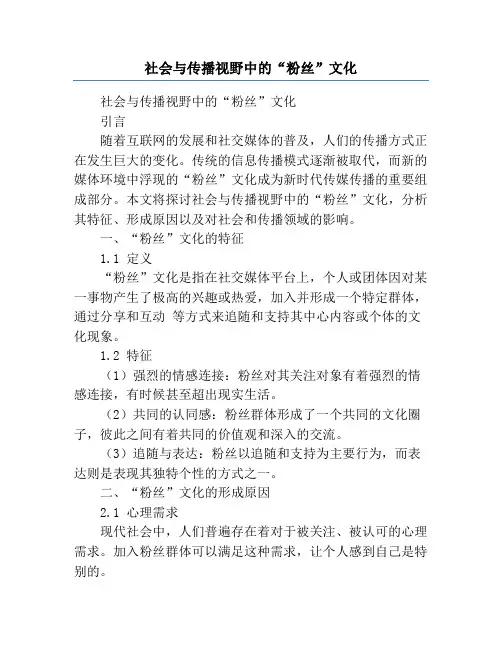
社会与传播视野中的“粉丝”文化社会与传播视野中的“粉丝”文化引言随着互联网的发展和社交媒体的普及,人们的传播方式正在发生巨大的变化。
传统的信息传播模式逐渐被取代,而新的媒体环境中浮现的“粉丝”文化成为新时代传媒传播的重要组成部分。
本文将探讨社会与传播视野中的“粉丝”文化,分析其特征、形成原因以及对社会和传播领域的影响。
一、“粉丝”文化的特征1.1 定义“粉丝”文化是指在社交媒体平台上,个人或团体因对某一事物产生了极高的兴趣或热爱,加入并形成一个特定群体,通过分享和互动等方式来追随和支持其中心内容或个体的文化现象。
1.2 特征(1)强烈的情感连接:粉丝对其关注对象有着强烈的情感连接,有时候甚至超出现实生活。
(2)共同的认同感:粉丝群体形成了一个共同的文化圈子,彼此之间有着共同的价值观和深入的交流。
(3)追随与表达:粉丝以追随和支持为主要行为,而表达则是表现其独特个性的方式之一。
二、“粉丝”文化的形成原因2.1 心理需求现代社会中,人们普遍存在着对于被关注、被认可的心理需求。
加入粉丝群体可以满足这种需求,让个人感到自己是特别的。
2.2 社交关系传统的社交圈子可能因为地理、兴趣等原因无法满足个人的需求,而互联网的出现打破了这种限制,粉丝文化则为人们提供了一个通过共同关注点进行社交的平台。
2.3 娱乐性与娱乐产业粉丝文化在一定程度上也具有娱乐性质。
许多娱乐明星或作品通过创造引人入胜的故事情节和形象,吸引了大批狂热粉丝。
娱乐产业则通过满足这些粉丝对明星或作品的喜爱和需求而获得巨大经济效益。
三、“粉丝”文化对社会的影响3.1 个体层面粉丝文化为个体提供了一个展示和表达自我的舞台。
这不仅让人们在现实生活中获得更多的认同感,也促进了个体的自我成长和认知。
3.2 社交层面加入粉丝群体使得个体可以与共同关注的人进行沟通和交流,形成了一个相对封闭的社交圈。
这种群体的结合不仅满足了人们的社交需求,同时也增加了社会联系和认同感。
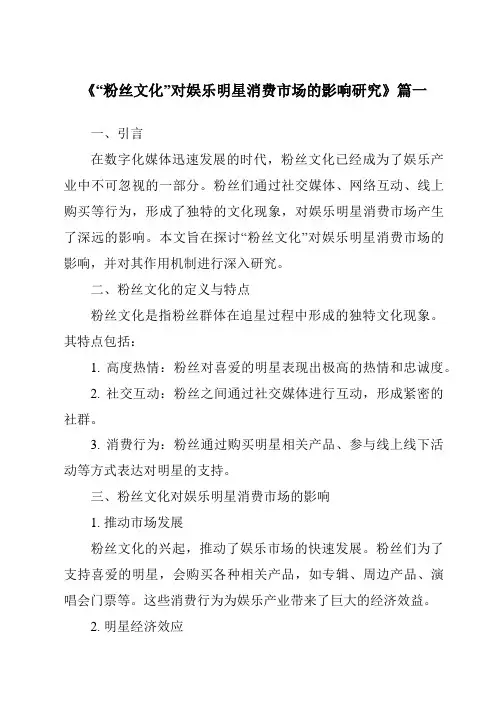
《“粉丝文化”对娱乐明星消费市场的影响研究》篇一一、引言在数字化媒体迅速发展的时代,粉丝文化已经成为了娱乐产业中不可忽视的一部分。
粉丝们通过社交媒体、网络互动、线上购买等行为,形成了独特的文化现象,对娱乐明星消费市场产生了深远的影响。
本文旨在探讨“粉丝文化”对娱乐明星消费市场的影响,并对其作用机制进行深入研究。
二、粉丝文化的定义与特点粉丝文化是指粉丝群体在追星过程中形成的独特文化现象。
其特点包括:1. 高度热情:粉丝对喜爱的明星表现出极高的热情和忠诚度。
2. 社交互动:粉丝之间通过社交媒体进行互动,形成紧密的社群。
3. 消费行为:粉丝通过购买明星相关产品、参与线上线下活动等方式表达对明星的支持。
三、粉丝文化对娱乐明星消费市场的影响1. 推动市场发展粉丝文化的兴起,推动了娱乐市场的快速发展。
粉丝们为了支持喜爱的明星,会购买各种相关产品,如专辑、周边产品、演唱会门票等。
这些消费行为为娱乐产业带来了巨大的经济效益。
2. 明星经济效应粉丝文化使得明星的商业价值得到充分体现。
许多品牌和商家会与热门明星合作,推出联名产品或代言广告,借助明星的影响力吸引消费者。
同时,明星的社交媒体影响力也为其代言的产品带来了更高的关注度和销售量。
3. 多样化消费需求粉丝文化的多样性导致了消费需求的多样化。
为了满足粉丝的不同需求,娱乐产业不断推出新的产品和服务,如虚拟偶像、粉丝见面会、明星周边产品等。
这些创新产品和服务为市场带来了新的增长点。
四、粉丝文化影响消费市场的机制1. 情感驱动:粉丝对明星的喜爱和崇拜是消费行为的主要驱动力。
他们愿意为喜欢的明星花费时间和金钱,以表达对偶像的支持和喜爱。
2. 社群影响:粉丝社群中的互动和交流也会影响消费行为。
在社群中,粉丝们会分享购买经验、推荐产品、参与线上线下活动等,形成一种集体消费的行为。
3. 媒体推动:社交媒体和互联网的发展为粉丝文化提供了更多的传播渠道。
通过社交媒体,粉丝可以更方便地了解明星动态、参与互动、购买相关产品等,进一步推动了消费市场的繁荣。
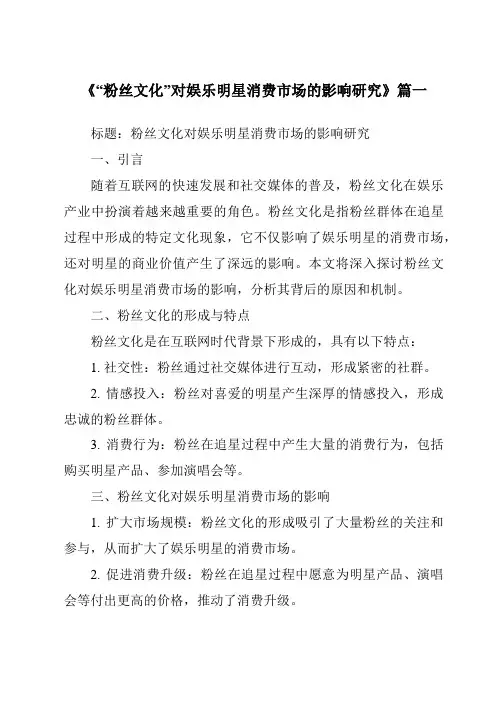
《“粉丝文化”对娱乐明星消费市场的影响研究》篇一标题:粉丝文化对娱乐明星消费市场的影响研究一、引言随着互联网的快速发展和社交媒体的普及,粉丝文化在娱乐产业中扮演着越来越重要的角色。
粉丝文化是指粉丝群体在追星过程中形成的特定文化现象,它不仅影响了娱乐明星的消费市场,还对明星的商业价值产生了深远的影响。
本文将深入探讨粉丝文化对娱乐明星消费市场的影响,分析其背后的原因和机制。
二、粉丝文化的形成与特点粉丝文化是在互联网时代背景下形成的,具有以下特点:1. 社交性:粉丝通过社交媒体进行互动,形成紧密的社群。
2. 情感投入:粉丝对喜爱的明星产生深厚的情感投入,形成忠诚的粉丝群体。
3. 消费行为:粉丝在追星过程中产生大量的消费行为,包括购买明星产品、参加演唱会等。
三、粉丝文化对娱乐明星消费市场的影响1. 扩大市场规模:粉丝文化的形成吸引了大量粉丝的关注和参与,从而扩大了娱乐明星的消费市场。
2. 促进消费升级:粉丝在追星过程中愿意为明星产品、演唱会等付出更高的价格,推动了消费升级。
3. 明星商业价值提升:粉丝文化的兴起使得明星的商业价值得到进一步提升,明星代言、广告等商业活动更加活跃。
四、影响机制分析1. 情感驱动:粉丝对喜爱的明星产生深厚的情感投入,这种情感驱动了他们在消费市场上的行为。
2. 社群效应:粉丝通过社交媒体形成紧密的社群,社群内的互动和分享进一步推动了消费市场的扩大。
3. 媒体宣传:媒体对娱乐明星的报道和宣传,进一步提高了明星的知名度和影响力,从而带动了消费市场的增长。
五、案例分析以某热门明星为例,其粉丝文化在消费市场上的影响表现为:1. 粉丝通过社交媒体积极参与明星的互动活动,如转发、评论、点赞等,为明星带来了大量的关注度。
2. 粉丝在追星过程中产生了大量的消费行为,包括购买明星专辑、周边产品、参加演唱会等。
这些消费行为不仅为明星带来了直接的经济收益,还提高了明星的商业价值。
3. 粉丝社群的形成进一步扩大了消费市场,社群内的互动和分享促进了更多人加入追星行列,从而推动了市场规模的扩大。

社会与传播视野中的“粉丝”文化社会与传播视野中的“粉丝”文化引言随着社交媒体的兴起和互联网的普及,粉丝文化在当代社会中变得日益普遍和重要。
不管是偶像粉丝、明星粉丝、球队粉丝还是电影粉丝,各种类型的粉丝群体都拥有强烈的热情和表达方式。
在这篇文章中,我们将从社会和传播的视角探讨粉丝文化对日常生活、社会互动以及传播媒体的影响。
社会角度下的粉丝文化粉丝文化不仅仅是一种追求娱乐和休闲的方式,它也是一种社交现象。
粉丝们通过共同喜爱的明星、偶像或团体建立了共同的身份与认同。
在粉丝群体中,成员之间往往建立起一种特殊的情感联系,他们共享类似的价值观、喜好、激情和经验。
这种共同体感觉给予了粉丝们安全感和归属感,从而在现实中寻找到一种社交和群体的依托。
除了建立社交联系,粉丝文化还能够对个人的自我认同和自我表达产生积极的影响。
粉丝通过表达对偶像的爱戴、追捧和支持来展现自己的价值观和兴趣。
他们通过购买周边产品、参加演唱会或活动等方式来表达对偶像的忠诚和喜爱。
这种当代“粉丝号召”现象不仅在社交媒体上存在,也涉及到了线下实体活动,从而构建起一种独特的粉丝文化现象。
粉丝文化的传播视野传播学角度下,粉丝文化是一种特殊的群体传播现象。
纵观粉丝文化的发展,传播媒体无疑起到了重要的推动作用。
粉丝们通过传媒的介入与推动,获取到了更多的信息、资源和交流渠道。
互联网和社交媒体使得粉丝们可以更加方便地获取和分享有关自己偶像的信息,从而进一步增强了粉丝活动的范围和影响力。
在传播视野中,粉丝文化还与营销活动密切相关。
各大品牌和营销商纷纷利用明星和偶像的影响力来推动产品销售。
通过与粉丝文化的紧密结合,品牌或者产品能够通过粉丝们对偶像的热爱和追捧来间接地获得消费者的认可和支持。
这种粉丝推动的营销模式已经成为现代传播中的一种重要方式。
然而,粉丝文化和传播之间也存在着争议。
一些观点认为,粉丝文化过度崇拜明星和偶像,导致粉丝们对大众价值观的依赖和模仿。
一些粉丝群体甚至被批评为“盲目追星者”或“没有个性的追随者”。
文化社会学视域中的粉丝现象解读粉丝现象,或称为歌迷文化、影迷文化等,在当代社会中日益流行,并成为人们生活中不可或缺的一部分。
粉丝们以狂热的热情和高度的投入支持着自己喜欢的偶像、音乐、电影等。
而在文化社会学的视角下,粉丝现象不仅仅是一种个体行为,更是社会文化环境和个体之间的复杂互动。
本文将从文化社会学的角度出发,解读粉丝现象对社会文化的影响和意义。
首先,可以看到粉丝现象在塑造社会文化的过程中发挥着重要的作用。
粉丝们对于他们喜爱的事物具有强烈的认同感,并通过各种方式来表达自己的支持和热爱,如参加演唱会、购买周边产品等。
这种认同感和表达方式不仅增强了个体的社会认同感和自我认同感,同时也构筑了一个特定的群体和社群。
这些群体和社群通过共同的喜好和行动目标,形成了一个共享价值观和文化符号的虚拟社交空间,从而加强了社会文化的凝聚力。
其次,粉丝现象在社会文化中也扮演着文化生成的角色。
无论是音乐、影视作品,还是其他形式的文化产品,都需要一定数量的受众群体来接受和支持。
而粉丝的存在提供了这样一个受众群体,他们的参与和投入不仅带来了经济效益,也为文化产品的创作和发展提供了源源不断的动力。
例如,某些影视剧因为粉丝们的热情追捧而获得了更多的关注和成功,而一些音乐作品也因为粉丝们的支持而走红。
粉丝们的参与和表达,推动了文化产品的多样化和丰富化,促进了文化创意产业的繁荣。
粉丝现象还对社会文化的价值观和审美观念产生了影响。
粉丝们对于他们喜爱的事物有着非常独特的美学追求和审美标准,这些追求和标准在一定程度上塑造了社会的审美观念。
他们通过对作品的演绎、重新创作以及二次创作,不仅展现了他们对美的理解和追求,也将这种理解和追求传递给了其他人。
随着粉丝文化的兴起,一些以前较为边缘化的审美元素也逐渐被主流文化所接受,而这些元素正是由粉丝们积极传播和推崇的。
因此,粉丝现象在一定程度上推动了审美观念的演变和多样化。
另外,粉丝现象也是社会文化的一种平台和载体。
《新媒体时代“粉丝”文化传播研究》篇一一、引言新媒体时代下,随着互联网的快速发展和信息传播技术的革新,各类媒介平台上“粉丝”文化逐渐成为一种引人注目的社会现象。
本文旨在探讨新媒体时代下“粉丝”文化的传播机制、特点及其影响,以期为理解“粉丝”文化提供新的视角和思考。
二、新媒体时代“粉丝”文化的定义与特点“粉丝”文化是指以偶像为核心,围绕其进行的一系列文化活动和社会行为。
在新媒体时代,这种文化呈现出以下几个特点:1. 高度互动性:粉丝可以通过社交媒体、网络平台等途径与偶像进行实时互动,表达喜爱和支持。
2. 高度聚集性:粉丝会通过各种渠道聚集在一起,形成特定的社群,共同关注和讨论偶像的动态。
3. 多样化传播:除了文字、图片等传统传播方式外,短视频、直播等新兴传播手段也广泛运用于“粉丝”文化的传播。
三、新媒体时代“粉丝”文化的传播机制在新媒体时代,“粉丝”文化的传播机制主要依赖于互联网和社交媒体。
具体而言,其传播机制包括以下几个方面:1. 社交媒体平台:通过微博、抖音、B站等社交媒体平台,粉丝可以关注偶像的动态,与其他粉丝进行交流和互动。
2. 粉丝社群:粉丝会通过各种方式聚集在一起,形成特定的社群,共同关注和讨论偶像的动态。
这些社群在传播“粉丝”文化方面发挥着重要作用。
3. 偶像经纪公司:经纪公司会通过官方渠道发布偶像的最新动态,引导和支持“粉丝”文化的传播。
四、“粉丝”文化的影响及挑战“粉丝”文化在一定程度上丰富了人们的文化生活,扩大了社会交往范围,但也带来了一些挑战和问题:1. 过度消费问题:在追求明星效应的同时,部分粉丝可能过度消费,导致经济负担加重。
2. 社交依赖问题:过度依赖社交媒体可能导致现实生活中的人际关系疏远。
3. 价值观引导问题:在追求偶像的过程中,部分粉丝可能忽视了对现实生活的关注和投入。
五、应对策略与建议针对上述问题,本文提出以下应对策略与建议:1. 引导理性追星:媒体和相关部门应加强对“粉丝”文化的引导,倡导理性追星,避免过度消费和社交依赖。
社会与传播视野中的“粉丝”文化社会与传播视野中的“粉丝”文化引言:随着科技的不断发展和社交媒体的普及,粉丝文化成为了当今社会的重要组成部分。
无论是影视作品、音乐、体育或者其他领域,都存在着一大批热情洋溢的粉丝群体。
本文将从社会和传播的视角,探讨粉丝文化的特点、影响以及其在当代社会中的重要性。
一、粉丝文化的特点:粉丝文化是指一群对某一特定事物或明星产生强烈共鸣的群体。
他们会追随、关注并表达对自己喜欢的事物或明星的热爱和支持。
粉丝群体通常会形成独特的社区,分享彼此的喜好、经验和情感。
他们通过各种途径获取信息,包括网络、社交媒体、粉丝聚会等。
粉丝文化还经常产生各种衍生产品,如周边商品、写真集、演唱会等。
二、粉丝文化的影响:1. 塑造明星形象:粉丝的支持和追捧对明星的形象塑造起着重要作用。
明星通过与粉丝互动、发布相关内容以及参与公益活动等方式,不断增强和巩固自己在粉丝心中的形象,进而推动事业发展。
2. 推动商业发展:粉丝对于周边商品的购买是商业运作中重要的一环。
各种粉丝衍生产品的销售推动了相关行业的发展,刺激了经济增长。
3. 形成社交群体:粉丝文化为拥有共同喜好的人们提供了交流和分享的平台。
通过线上和线下的社交聚会,粉丝之间建立了紧密的联系,形成了团体认同感,从而带来了情感上的满足和社交上的愉悦。
三、粉丝文化的重要性:1. 粉丝文化促进了文化产业的繁荣。
粉丝的支持和热爱使得各种文化产品得以广泛传播和推广,为文化产业带来了新的商机和发展机遇。
2. 粉丝文化拉近了明星与粉丝之间的距离。
通过互动和交流,明星能够更好地了解粉丝的需求和心理,进而更好地满足他们的期待,形成良好的艺人与受众关系。
3. 粉丝文化提升了大众参与感和身份认同感。
粉丝群体的存在使得支持者们能够找到归属感,并与他人分享与自己喜好相关的经验,共同构建着一个交流友好的社区。
结论:粉丝文化在当代社会中具有重要的意义。
它不仅推动着文化产业和商业的发展,同时也成为了粉丝和明星之间情感交流的桥梁,提升了大众的参与感和身份认同感。
粉丝社群文化的作用粉丝社群文化是指一群人基于共同喜好、兴趣和价值观所形成的社群。
它对于现代社会有着重要的作用,其中包括以下几点:1. 社交平台。
粉丝社群文化使得那些不同地区、不同背景的人可以在互联网上聚集在一起,共同分享快乐、交换意见和建立友谊。
社交平台提供了一个沟通和互动的场所,让人们更容易地获得信息和发声。
2. 文化共鸣。
当一些人因为共同的愉悦、感慨或悲伤而聚集在一起时,他们往往可以通过交流、分享和参与活动来进一步加强彼此的文化共鸣。
这可以加强人们对文化和传统的认同感,并加强他们的文化身份认同。
3. 娱乐产业的发展。
粉丝社群文化已经成为了娱乐产业最重要的组成部分之一,因为利润丰厚的娱乐作品通常都受到粉丝社群的支持。
粉丝社群也可以影响娱乐产业的发展方向,同时也可以成为娱乐企业通过客户关系管理系统(CRM)获取客户信息和市场调查的重要渠道。
4. 社会行动力。
粉丝社群在某些情况下可以成为社会运动的主要推动力,促使政府和企业进行改革,提高人权和福利,建立新的社区资源和教育设施等。
在这个过程中,粉丝社群和其他支持者可以通过网络和现实交流,制定策略,提高声音,增加威力。
5. 营销利器。
粉丝社群文化对于企业来说也是一种致命的营销利器,企业可以根据社群的兴趣爱好来定向推广产品和服务,提高品牌知名度和满意度。
企业还可以与粉丝社群合作或邀请其成为自己的代言人,扩大影响力和经济效益。
总之,粉丝社群文化在现代社会中的影响力不断扩大,它不仅是社交和娱乐的场所,也是一种文化和社会的重要力量。
研究粉丝文化的意义稿子一:嘿,朋友!咱们今天来聊聊研究粉丝文化的意义,这可有意思啦!你知道吗,粉丝文化就像一个大大的宝藏,藏着好多好多有趣的东西。
研究它能让我们更懂现在年轻人的心思和喜好。
比如说,那些疯狂追爱豆的粉丝们,他们为啥会这么投入,这么痴迷?搞清楚这个,咱就能更好地和年轻人交流,不会有代沟啦。
而且哦,粉丝文化能反映出社会的变化。
以前咱们追星可能就是听听歌、看看电影,现在可不一样啦,有各种社交媒体、线上活动。
这说明啥?说明科技在改变我们的生活方式,也在改变粉丝和明星互动的方式。
研究这个,不就等于在研究社会发展的新趋势嘛!还有啊,粉丝文化对于经济的影响也很大呢!粉丝们为了支持自己的偶像,会买周边、看演唱会、买代言产品。
这带动了好多产业的发展,创造了好多就业机会。
通过研究,能让商家们更聪明地抓住商机,推动经济的繁荣。
另外,研究粉丝文化还能让我们看到人性的闪光点和弱点。
粉丝们的团结、热情,那是满满的正能量。
但有时候也会有过度狂热、不理智的行为。
了解这些,能帮助我们引导大家更健康、更积极地追星。
怎么样,是不是突然觉得研究粉丝文化超级有意义?稿子二:亲,来聊聊研究粉丝文化的意义呗!你想想,粉丝文化就像一个热闹的大舞台,上面演着各种精彩的戏码。
研究它,能让我们走进粉丝们的内心世界,知道他们为啥会为了一个人或者一个团体那么疯狂。
这可不光是为了满足好奇心哦,它能帮助文化产业发展得更好。
比如说,影视公司知道粉丝喜欢啥样的剧情、角色,就能拍出更受欢迎的作品。
音乐公司了解粉丝的口味,就能推出更爆款的歌曲。
从个人角度来说,研究粉丝文化能让我们自己变得更包容。
可能以前不理解那些追星的人,但深入研究后,就会明白每个人都有自己的热爱和追求,就不会轻易去嘲笑或者否定别人啦。
而且呀,这对教育也有帮助呢!老师和家长了解粉丝文化,就能更好地引导孩子正确追星,让他们在喜欢偶像的同时,也不耽误学习和成长。
你看,研究粉丝文化是不是一件特别有价值的事儿?。
关于粉丝文化的管理一、引言粉丝文化是指以某个明星、偶像或者团体为核心,由一群热爱他们的人组成的社群。
在现代社会中,粉丝文化已经成为了一个重要的文化现象,并且在互联网上得到了广泛的传播和发展。
然而,随着粉丝文化的不断壮大,也带来了一些问题和挑战。
本文将从以下几个方面探讨如何进行粉丝文化的管理。
二、粉丝文化管理的必要性1.防范不良行为由于粉丝对明星或者偶像的热爱程度很高,有时候会出现一些不良行为,比如侵犯隐私、恶意攻击其他艺人等。
这些行为不仅会影响到明星或者偶像本人,还可能会给其他粉丝带来负面影响。
2.提升用户体验一个好的粉丝社群应该是一个友好、和谐、积极向上的环境。
只有这样才能吸引更多的人加入进来,并且保持活力。
因此,对于那些破坏社群氛围的行为需要及时处理,以保证用户的良好体验。
3.维护品牌形象对于明星或者偶像来说,他们的形象是非常重要的。
一个好的粉丝社群可以为他们树立良好的形象,反之则可能会给他们带来负面影响。
因此,需要对粉丝文化进行有效的管理,以维护明星或者偶像的品牌形象。
三、粉丝文化管理的方法1.建立规范为了防范不良行为,需要建立一套规范来引导粉丝的行为。
这些规范应该包括:禁止侵犯隐私、禁止恶意攻击其他艺人、禁止发布虚假信息等。
同时,还需要制定相应的处罚措施,以保证规范得到落实。
2.加强监管除了建立规范之外,还需要加强监管力度。
这包括:设立专门部门负责监管、定期巡查社群、及时处理违规行为等。
只有通过加强监管才能有效地防范不良行为,并且保持社群环境的和谐。
3.提供优质服务一个好的粉丝社群应该是一个充满活力、有趣、有价值的环境。
因此,需要提供优质的服务来吸引粉丝。
这些服务可以包括:定期举办线上或者线下活动、提供专属礼品或者福利、为粉丝提供与明星互动的机会等。
4.加强沟通一个好的粉丝社群应该是一个开放、透明的环境。
因此,需要加强与粉丝之间的沟通。
这包括:定期发布公告、回答粉丝提问、及时处理反馈等。
THE HISTORY AND SIGNIFICANCE OF THE CUL TURE OF FANS STUDIESXI RAO(Department of humanities I I T,Chicago, Illinois 60616 )[Abstract] this article traces the image, activities, and meaning of fandom. Fans were portrayed as deviant creatures until the late 1980s. This image was clarified when people looked into fans and their creative works. Scholars realized that fans productively generated creative products based on the given materials, which reflected the social experience of the creators. Therefore, fandom was soon understood as a way of fans to resist the dominant culture in the society.【KEYWORDS】TV F ANDOM;F ANDOM; DOMINANT CUL TURE;RESIST作者简介:饶曦(1991—),女,湖北十堰人,美国伊利诺伊理工学院人文学院信息架构理学博士,主要从事信息架构科学研究。
INTRODUCTIONIn 2014, people sent 576,000 tweets, on average, during each episode of The W alking Dead (Nielsen, 2014a). AMC’s show, which is seen by 14 million viewers, reached 4,934,000 people on Twitter (Nielsen, 2014b). Also, 2,491,473 unique users on Facebook made 4,477,454 activities (including posts, comments, likes, shares) related to Breaking Bad around the episode airing on Sept 29, 2013 in total (Facebook for Business, 2014). Audiences are clearly using social media to be involved with television. What we don’t know is (1) what are they doin g, and (2) why does any of it matter? This paper addresses these two questions by situating fans’ current social media practices in the context of fan studies from the late 20th century and examining the impacts fans’ social media behaviors have on television production and on fans themselves.1 A Brief History of TV FandomImages of deviance haunt the literature on TV fandom (see Miller, 1989; Johnson, 1987; Caughey, 1978). Until the late 1980s, researchers consistently characterized fans as fanatics or potential fanatics, meaning that TV fandom was seen as excessive, bordering on deranged, behavior (Jenson, 1992; Jenkins, 1992). As Jenson (1992) summarizes, researchers discuss deviant fandom as two types: the obsessed individual and the hysterical crowd.In the “obsessed individual” characterization, individuals, usually loners, enter into an intense fantasy relationship with a particular celebrity. They then achieve public notoriety by stalking, threatening, or killing the celebrity (e.g., Robert John Bardo, who killed actress Rebecca Schaeffer after stalking her for three years). An article in People W eekly on Schaeffer’s murder blames TV shows in the United States for influencing fan obsession, “This country has been embarking for a long time on a fiel d experiment in the use of violence on TV… W e’ve given the losers in life or sex a rare chance to express their dominance” (Lewis, 1992). Fans were regarded as mindless, immature consumers who don’t have any “important” things to do in daily life except de voting their lives to the useless knowledge of the programs. For instance, William Shatner of Star Trek fame, said, “Get a life!” to fans during an appearance on Saturday Night Live (Jenkins, 1992).The “hysterical crowd” characterization refers to groups such as screaming teens waiting to glimpse a rock star. “Five thousand shrill female voices come in on cue. The screeching reaches the intensity of a jet engine. When Elvis comes striding out on stage with his butchy walk, the screamssuddenly escalate (Le wis, 1992, p. 99).” Mass hysteria is inevitable. It is announced and ratified teen sexuality and amplified teen sexual frustration almost beyond endurance.Whether individually or in groups, fans were seen as being irrational, out of control, deviant, exc essive creatures. Though some literature admits the existence of “normal” fans, researchers express concern that “normal” fans will eventually become obsessed loners or hysteric crowd members (Jenson, 1992). This worry comes from questioning the fans’ abil ities to distinguish appropriate and inappropriate behaviors displayed on the television screen and to separate TV programs from the reality. Hence, even currently normal fans are potentially dangerous.Meanwhile, fans are looked as a group of people who do not have a “real life” because they are spending so much time and money on supporting meaningless TV shows. The negative stereotype portrayed by the media shows fans as mindless consumers, cultural dupes, and social misfits (Jenkins, 1992).Many of these arguments about fandom concentrate on deviant, excessive behaviors by distinguishing fans from “us.” Jenson points out that scholars such as Schickel explains that the “forces” that function in arousing the deranged behavior of fans also affect “us,” bu t in a much milder measure (Lewis, 1992). These statements develop a deviant image of fans, which is a deranged version of “us.” Fandom is conceived as a pathology of the society, as a way to compensate the fan’s incomplete personality. This threatening, n egative image of fandom lasted until early 1990’s when scholars (e.g., Jenkins, 1992; Jenson, 1992; Bacon-Smith, 1992) denied the “other” conception in “fans” vs. “us.”By replacing “fans” with “us,” Jenson (1992) proposed the new assumption: W e are fans. The argument applies the fandom label to “us” or “we” by arguing that as aficionados, professors, and many other roles, we are also fans. Fans are not “others” to be condescended to and maligned, fans are “us.” Under this framing, fans have both lives and are not deviant because they are not just some distant other but rather ourselves. Moreover, Jenkins (1992) points out that by being represented as “others,” fans which amount to a projection of anxieties about the violation of dominant cultural hierarchies, do not pollute a sanctioned culture. This condescension toward fans is a result of classism, misogyny, and other kinds of hostility or aggression in the society (Jenson, 1992). Distinguishing fans from us by giving them an incomplete, fragile personality, enables us to claim that we are not these unstable, vulnerable people. Unlike the deviant, obsessed fans, we are in touch with reality.After Jenkins, and other similar arguments such as Bacon-Smith (1992), the understanding of TV fandom in academic literature has gradually changed. Deviant, obsessed conceptions of fans are replaced by “normal” descriptions as researchers start to accept that irrationality is not a necessary characteristic of fandom. Researchers realize that the misunderstanding of fandom is in part caused by the condescension of people who want to announce their culture “clean” (Tulloch & Jenkins, 1995).This change in image of fandom is regarded as the phase of “fandom is beautiful” (Gray, Sandvoss, & Harrington, 2007). Fandom is re-coded from pathological to creative, thoughtful, and productive (e.g. Fiske, 1992; Jenkins, 1992). At the turn of the century, some scholars started to emphasize the political meaning of fandom: fandom is a way of resisting the “power bloc” (the term most notably mentioned in Fiske, 1989) in the society (Hills, 2002). However, some theory emphasizes the productive practice of fans too much while rarely mentioning those fans who merely watch the show and do not engage in their own textual production (e.g., fanvids, fan fictions). Therefore this statement runs the risk of isolating the active “fans” from “us.” Also, the political meaning of fans’ participation is questioned because fans themselves probably are not aware of the political meaning within their activities (Hills, 2002).Moreover, from the development of the Internet, fans can approach the discussion about the fan object almost everywhere through cell phones, laptops, blackberries, etc. Hence, the specific forms ofsocial interaction that take place between fans have became an ever more integral part of everyday life in modern societies (Gray, Sandvoss, & Harrington, 2007).To summarize, the image of fans has changed from deviant creatures to normal people. Additionally, fandom is regarded as resistance to the mainstream culture. With the Internet, fans can approach texts by convenient and immediate ways in different situations, which makes fandom emerge as an integral aspect of our daily lives. These changes vary as people look into fans activities such as creating fan fictions and making fanvids.2 what Do tv fans do?Fans create and share fan fiction. At the very beginning, fans share knowledge or make new meanings collectively by passing textual products such as letters through mail or ordering individual stories on loan from a central library (Jenkins, 1992), or passing hand to hand at conventions (Jenkins, 2006). In this way, some of the fans write stories and then others only need to pay the cost of postage to approach those texts, and it is encouraged that readers have their own copies by this means. Fans also make fanzines to convey their fan fictions, reviews of shows, letters from the subscribers, interviews from conventions with writers or artists, etc (Bacon-Smith, 1992). The first science fiction fanzine, The Comet (see figure 1), was published in 1930 by the Science Correspondence Club in Chicago and edited by Raymond A. Palmer and W alter Dennis (Danesi, 2013), which is a nonprofessional and nonofficial publication produced by fans of a particular cultural phenomenon for the pleasure of others who share their interest. Through this medium, many fans turn to write for zines to support their zine-buying habits (Jenkins, 1992). As a result, writers, editors, and readers interact with each other directly and perpetuate the fandom.Figure 1. The cover of the first science fanzine: The CometFans orga nize and/or attend conventions (also known as “cons”). A convention is a prearranged gathering of fans at a specific place and time. A convention can be used to share knowledge of the show, exchange the fan fictions or fanzines, or create texts together. It can focus on a specific topic or fandom, e.g., Vividcon, a 125-person convention devoted specifically to fannish vidding1, or a general convention for all fandoms of their type (media, slash, etc.: e.g., Escapade2, a general slash con, open to all slash fans [Fanlore, 2013].1/2/43584.htmlAs the popularization of computers and the development of the Internet, new tools including blogs, forums, fan discussion groups, mailing lists, and social networks enable TV fans to archive, annotate, appropriate, and recirculate media content (Jenkins, 2004).With the rise of video editing software such as iMovie3, or After Effects4, fans contribute to create various artworks, e.g. vidding (also known as vid). Vidding is a form of grassroots filmmaking in which clips from television shows are set to music. Viddings use music in order to comment on or analyze a set of preexisting visuals to tell new stories, in which music is used as an interpretive lens to help the viewer to see the source text differently(Coppa, 2008). The first vidding appeared in 1975; a fan named Kandy Fong showed a slide5called “What Do Y ou Do With a Drunken Vulcan?” at a Star Trek convention that used a recording of Leonard Nimoy singing a Joni Mitchell song (Ulaby, 2009; Coppa, 2008).Besides all the creative works, fans also start movements and try to directly intervene with TV production. For instance, in 1967, and again in the 1967-68 season, fans of the TV program Star Trek produced over a million letters (see figure 2) to NBC to protest the threatened cancellation, resulting in the renewal of the show (Brower, 1992). In the digital age, fans can quickly start a grassroots movement to save a program or protest unpopular developments (Jenkins, 2006). As case in point, fans found the finale of How I Met Y our Mother unacceptable when it aired on March 30, 2014, and viewers took to social media to trash the polarizing ending (Romano, 2014). Some even created their own endings in which dad T ed and mom T racy got married and lived a happy life together (O’Brien, 2014). Facing the harsh comments, creator Carter Bays took to T witter to explain the reasoning (see figure 3) behind the ending and released an alternate finale five months later (Desta, 2014).Figure 2. Letter samples from Star Trek fansFigure 2. Fans show disappointment3iMovie is a video editing software application sold by Apple Inc4Adobe After Effects is a digital visual effects, motion graphics, and compositing application developed by Adobe Systems and used inthe post-production process of filmmaking and television production.5/Members/fcoppa/clips/kandy-fongs-first-slideslow/viewFigure 3. Carter Bays explains the finaleTo conclude, there are three common kinds of things that fans do. The most basic one is collecting knowledge of the program, including reading fan fictions, reading fanzines, and searching the program related news online. The second one is sharing, or say propagating knowledge of the program, such as retweeting an event of the program. The last and the most influential one is making meaning of the program. This includes any kinds of compositions, such as writing fan fictions, viddings, or making meaningful comments online. From these activities, the actual TV production is often affected.3 WHY DO FANS MA TTER?Now we know what TV fans do. But why would all these behaviors matter? What can we achieve by analyzing the fans’ activities? This section explains why fans matter and what we can lea rn from understanding fandom. The two main reasons fans and their behavior matter are that they (1) champion the disadvantaged as a manifestation of the social hierarchies and (2) influence television production.3.1 Fan CommunityW e know that fans are participatory in poaching the materials on TV shows. During the process of redressing the deviant image of fandom, scholars took their particular inspiration from de Certeau’s (1984) distinction between the strategies of the powerful and the tactics of the disempowered. Fans, as vulnerable groups, are using guerrilla-style tactics (Fiske, 1989) to resist the mainstream culture (Gray, Sandvoss, & Harrington, 2007). Highfield and his colleagues (2013) find that people address social issues by using the event’s topic as a vehicle to catch the attention of a wider audience. In this case, fandom is regarded as resistance to the dominant culture. Therefore, fandom matters because it represents and champions those disadvantaged, particularly those disempowered by a combination of gender, age, class, and race, within society.In addition, Jenkins’s (1992) canonical T extual Poachers considers fandom more than a mere act of being a fan, but a collective strategy, to form communities that evades the intended meaning of the “power bloc” (Fiske, 1989) represented by popular media. Subsequent works including Baym (1999), Bacon-Smith (1992), and Jenkins (2006) have illustrated that fandom is one of those spaces where people collaborate within a knowledge community. A knowledge community, also called a community of practice, is a group of people who share a concern or a passion for something they do and learn how to do it better as they interact regularly (Wenger, 1998). This group can evolve naturally with the members’ comm on interest in a particular domain or area, or it can be created specifically with the goal of gaining knowledge related to their field. It is through the process of sharing information and experiences with the group that the members learn from each other, and have an opportunity to develop themselves personally and professionally (Lave & W enger, 1991). As a community of practice, fans share their knowledge of the program, sometimes with a thought of “showing off for one another” (Fiske, 1992), in order to expand a community’s productive capacity. Different from simply sharing knowledge, fans are motivated not solely by a pleasure in knowing but also a pleasure in exchangingknowledge (Jenkins, 2006). Fan communities produce products including letters that fans use to communicate or create together, fan fictions that utilize the same characters in the original show but make different meanings, zines, and other kinds of creative works. These products function both as creative outlets and as tools to propagate the group’s identity (Jenkins, 2006). The new meanings created reflect the existing social issues of this disempowered group or the way things really are in the world in which the writer actually lives (Sandvoss, 2005; Bacon-Smith, 1992). Like Bacon-Smith (1992) points out, women talk about their struggle for dignity in their relationships in their fan fiction, even though few television stories about women seem to postulate institutional dignity or equal status for women. From this perspective, fans matter as resistance that champion the disadvantaged.Though the view that thinking fandom as resistance provides a strong reason to study fandom, it’s necessary to examine two major reasons why thinking fans as communities attract increasing scrutiny. First, it’s too common for fans to be dismissed as “others.” The characteristics of productivity and collectivity in turn appear to set the practices of fans apart from other, less productive audience groups.Y et, this ubiquity of fandom challenges notions of fan dom as exceptional and distinct from “normal audiences” (Fiske, 1992). However, as summarized by Gray, Sandvoss, and Harrington (2007), the “other” is always a reflection of ourselves and is imbued with significant desire and longing of us. Hence, fans still matter.Second, the political meaning of fan production may be overstated. Hills (2002) questions that fans may not recognize the political meaning of their production as a part of the popular culture mentioned by Fiske (1989).3.2 Fans and the TV IndustryThe public recognition and evaluation of being a fan has profoundly changed since themid-1990s when we have moved from an era of broadcasting to one of narrowcasting (Gray, Sandvoss, & Harrington, 2007). Fan audiences are wooed by cultural industries with the rise of new media. Treating fans as specialized yet dedicated consumers has become a centerpiece of media industries’marketing strategies. As fans become mainstream consumers and supporters of the TV show, whether a TV program succeeds or not, to a certain extent, depends on the choice of fans.Fans can influence what shows will air. In 1981, Buffy Johnson, a mother and a fan of Hill Street Blues, organized a letter-writing campaign, pleaded with potential sponsors, and urged journalists to cover the show in their columns to support the new Hill Street Blues; fans of Cagney & Lacey were inspired by the producer and saved the show through letter-writing campaign (Brower, 1992); after fan pressure, Netflix makes Daredevil accessible to the blind by providing audio descriptions of the program (NPR, 2015). Besides simply watching the show, fans play an important role in determining the fate of the TV program. The industry takes letters seriously from fans who try to participate in and thus influence the production of the text (Fiske, 1992). These cases indicate that fans, to some extent, are invested in the program’s continuance by directly writing to the network to support their favorite show, or engaging in other activities that can influence the destiny of the show: for instance, fans urge journalists to cover the show in their columns to impact other viewers. As shown in the transcript provided by Robert Sabal (1992) of the first annual Faculty Seminar sponsored by the Academy of Television Arts and Sciences in November, 1988, those TV industry representatives will be able to give programs a chance because of publicity campaigns. Methods such as starting letter campaigns or talking to people who cover the media, benefit the show by drawing more public attention. This evidence demonstrates that fans play an important role in determining the fate of the TV program.epiloguefans give us a way to understand modern society, and fans can influence TV production. Some scholars think fandom is a kind of resistance against the dominant culture. From this perspective,fandom matters because it champions the disadvantaged. While other scholars take fandom as a manifestation of the modern society which reflects the hierarchy of the society. In both ways, studying fans allow us to effectively explore cultural issues in modern society. Fans also influence the production of a TV program through different ways, such as expressing their love to the network and the producer, or urging journalists to report their belove d show in order to impact others’ views towards the program. All in all, fans matter as they are not spectators but also participants in TV production.关于电视粉丝文化的历史及意义研究饶曦(伊利诺伊理工学院人文学院;芝加哥伊利诺伊60616)【摘要】本文追溯了的粉丝文化形象、活动及意义。